The Ultrasonic Sensors Market is estimated to be valued at USD 7.2 billion in 2025 and is projected to reach USD 22.4 billion by 2035, registering a compound annual growth rate (CAGR) of 12.0% over the forecast period.

The ultrasonic sensors market is experiencing sustained momentum as industries pursue precise, contactless sensing solutions for automation, safety, and measurement applications. The miniaturization of sensor modules, combined with advancements in digital signal processing, has broadened their functionality in diverse operating environments.
Market expansion is being fueled by increased deployment in industrial automation, smart mobility, healthcare diagnostics, and robotics. As OEMs focus on embedding sensors with higher sensitivity and durability, integration with microcontrollers and edge computing systems is becoming more prevalent. Furthermore, increasing vehicle electrification, factory automation, and adoption of autonomous equipment are creating strong use cases for ultrasonic sensors.
The shift toward Industry 4.0 and connected devices is also prompting the need for non-invasive sensing to support real-time data acquisition and decision-making. Future growth is expected to be supported by innovations in MEMS design, wireless connectivity, and multi-sensor fusion, enabling new use cases across both consumer and industrial sectors.
The market is segmented by Type, Application, and Industry and region. By Type, the market is divided into Proximity Sensors, Retro-reflective Sensors, Through Beam Sensors, and Others. In terms of Application, the market is classified into Object Detection, Distance Measurement, Liquid Level Measurement, Anti-collision Detection, and Others. Based on Industry, the market is segmented into Automotive, Medical, Oil & Gas, Industrial, Food & Beverages, and Others. Regionally, the market is classified into North America, Latin America, Western Europe, Eastern Europe, Balkan & Baltic Countries, Russia & Belarus, Central Asia, East Asia, South Asia & Pacific, and the Middle East & Africa.
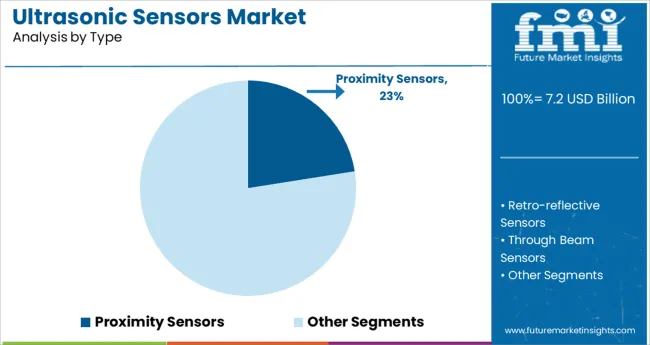
Proximity sensors are expected to contribute 22.5% of the overall ultrasonic sensors market revenue in 2025, making it the leading segment within the type category. This dominance is being driven by their high adaptability in detecting the presence or absence of objects without physical contact, which is critical in automation and safety-focused applications.
These sensors are widely deployed in environments where mechanical switches are less reliable due to dust, moisture, or vibrations. Their ability to offer stable performance in variable lighting and environmental conditions has made them essential across industrial and automotive systems.
Additionally, the integration of advanced filtering algorithms and diagnostics features within proximity sensors has enabled higher accuracy, fewer false triggers, and enhanced safety compliance. The growth of automated production lines, smart packaging systems, and intelligent traffic management has further reinforced demand for proximity sensors as a reliable type of ultrasonic sensing technology.
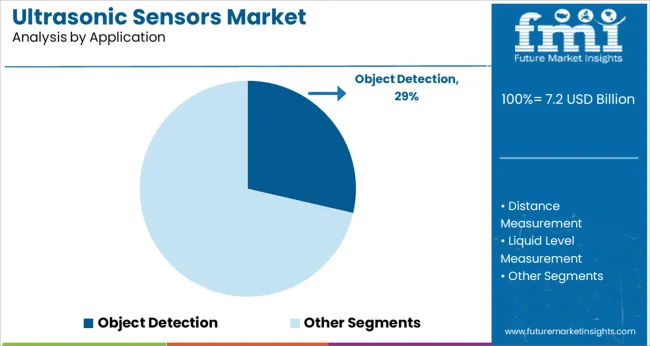
The object detection segment is projected to account for 28.6% of ultrasonic sensor application revenue in 2025, positioning it as the top application area. This is driven by the growing need for precise, real-time object localization and movement tracking in automated systems.
Ultrasonic sensors have become essential in detecting static or moving objects, especially in low-visibility or harsh environmental conditions where optical sensors may falter. Applications in robotics, vehicle assistance systems, conveyor automation, and security systems have prioritized the use of object detection capabilities for collision avoidance and smart response.
The ability to detect objects at varying distances with high resolution and without interference from color or surface texture has added to their appeal. Ongoing advancements in signal processing and software calibration have improved detection accuracy, while compact module design is supporting integration into space-constrained environments, solidifying object detection as a dominant use case.
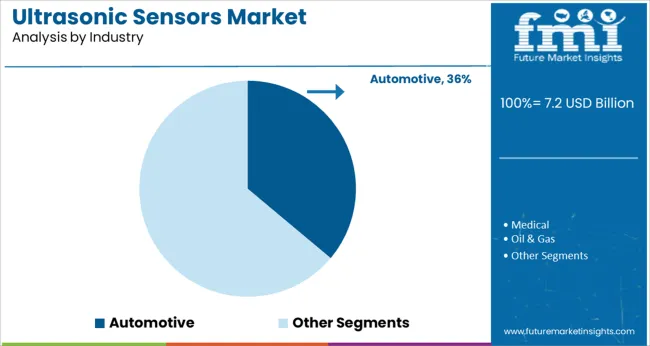
The automotive segment is projected to lead the ultrasonic sensors market by industry share, accounting for 36.1% of the total revenue in 2025. This segment’s growth is fueled by the increasing integration of ultrasonic sensors in advanced driver assistance systems, electric vehicles, and parking assistance modules.
Automakers are deploying these sensors to enable functionalities such as blind spot detection, obstacle recognition, lane change support, and autonomous emergency braking. Regulatory focus on passenger safety and vehicle automation has further prompted mandatory adoption of proximity and object detection sensors in passenger and commercial vehicles.
As electric and hybrid vehicles become mainstream, the demand for lightweight, power-efficient sensing solutions is rising, and ultrasonic technologies are meeting these needs. Automakers are also leveraging these sensors to enhance in-cabin features like gesture control and occupant monitoring. The reliability, affordability, and durability of ultrasonic sensors under varied environmental conditions have secured their role in the evolving automotive electronics ecosystem.
| Market Statistics | Details |
|---|---|
| H1,2024 (A) | 8.7% |
| H1,2025 Projected (P) | 11.2% |
| H1,2025 Outlook (O) | 11.5% |
| BPS Change : H1,2025 (O) - H1,2025 (P) | (+) 33 ↑ |
| BPS Change : H1,2025 (O) - H1,2024 (A) | (+) 276 ↑ |
The ultrasonic sensors market is expanding as a result of the increasing use of ultrasonic sensors in a variety of industries for distance measurement, object detection, and pallet detection. It is anticipated that the market will benefit from the rising demand for these systems in the medical sector for echocardiograms and echo graphs.
As per Future Market Insights, an increase of 33 units in BPS values noticed in the ultrasonic sensors market in H1, 2025 – Outlook (O) over H1, 2025 Projected (P). For the non-destructive examination of objects, such as the inspection, quantitative testing, and health monitoring of historic buildings, ultrasonic sensors are used. In challenging conditions where optical sensors are useless, they are very helpful.
Moreover, compared to H1, 2024 (A), the ultrasonic sensors market increased by 233 BPS in H1 -2025. As per FMI, modern ultrasonic sensors are used in agriculture to measure crop height, look for pesticides, dust, and water levels for irrigation. Additionally, they are used in hazardous environments to detect high-pressure that emit ultrasonic sound.
The global ultrasonic sensors market was valued at USD 4,622.0 Million in 2024. Adoption of ultrasonic sensors is increasing in robotics to implement a real-time obstacle avoidance system for robot, so that robot can continuously detect the surrounding. Ultrasonic sensors are widely used in robotics as these sensors are not affected by moisture, dust, and dirt and are also used in a dark environment since the light does not affect the sensor’s detection ability.
Ultrasonic sensors are used in robotics to avoid the obstacle in their way, so that they can move toward the target area. Moreover, ultrasonic sensors are utilized to detect the large obstacle and to obtain information between the robot and obstacle.
Ultrasonic sensors also help robots for object detection, tracking an object, and detecting the position of object. The adoption of robots is increasing in various sectors including healthcare, logistics, manufacturing, and others.
In urban areas, increasing congested traffic results in large number of accidents at low speed. To improve the road safety and satisfy government regulations, automobile manufacturers are adding a range of diverse technologies that can help drivers to avoid accident while driving and for these ultrasonic sensor based advanced driver assistance system is used. ADAS improve comfort, energy efficiency and convenience.
Ultrasonic sensors detect the obstacle and warns the driver in advance of possible collision in a congested traffic environment. These sensors are placed on the front and rear bumpers so that it helps in determining the speed and distance through sound waves. It is generally used at low speed and at short distance for blind-spot detection and obstacle detection.
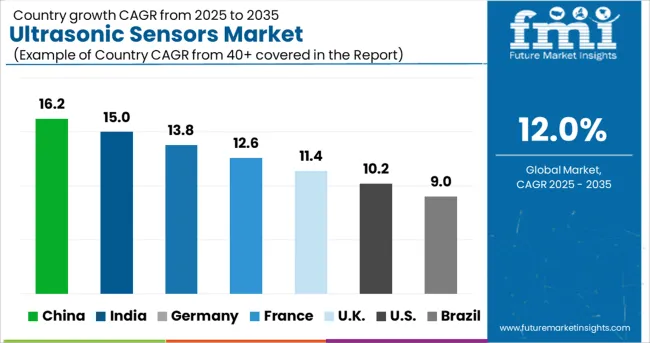
USA market is set to register exponential demand growth of ultrasonic sensors in the North America region with a CAGR of around 7.6% during 2025-30.
According to FMI analysis, in 2024, North America and Europe dominated the ultrasonic sensors market. Analysis suggests that the incremental $ opportunity for USA ultrasonic sensors market is estimated at USD 7.2 Million for 2025-2035. USA is offering the opportunity for revenue generation, owing to introduction of advanced technologies and increasing investment by companies in various sectors for smart production techniques and process automation.
The ultrasonic sensor in USA is estimated to grow approximately by 4.5% Y-o-Y from 2024 to 2024.
India market is set to register a noteworthy growth in the ultrasonic sensors industry after China, and market size is expected reach 4.3X by 2035. The Indian market is anticipated to create an absolute dollar opportunity of USD 600.7 Million during 2025-30.
In South Asia & Pacific, densely populated economy of India contributes approximately 15% towards global population as the pregnancy rates are increasing the demand of obstetric ultrasonic transducer in medical sector.
Moreover, due to rising awareness about ultrasonic treatments is increasing the demand of ultrasonic sensors in the region. Also, increasing awareness regarding smart agriculture is one of the major factor that is driving the growth of ultrasonic sensors market in the region.
The ultrasonic sensors in automotive sector is estimated to dominate the global sales of ultrasonic sensors, and expected to grow by 3.2X between 2025 & 2035. Moreover, automotive segment accounted the major market share of 21.7% in 2024.
Ultrasonic sensors are used as motion sensors in home automation systems. Sensor technology helps in solving many problems when it comes to protecting home from damage. Ultrasonic sensors help in improving convenience and performance while reducing energy consumptions. These sensors senses motion or presence of an object by obstructing the transmitted ultrasonic waves.
The sensors help in boosting energy savings through the heat, control of lights and other energy consumers. Ultrasonic sensors are used for turning the lights on and off with motion detection. Also, these sensors are in smart valve kit helps in detecting the water level in the tanks which prevents excessive damage due to flooding.
The medical industry accounted for around 21% market share in the global ultrasonic sensors market in 2024. The medical field has multiple applications of ultrasonic sensors which include lithotripsy, echocardiography, and ultrasonography.
The demand is increasing for ultrasonic sensors for medical applications as these sensors are risk-free substitute to radiography solutions and alternative to piezoelectric sensors. Ultrasonic sensors are widely used in medical applications as these sensors can visualize the internal condition of the human body without any damage.
Ultrasonic sensors are used for various medical inspection including diagnosis of internal body organs like kidneys, liver, gallbladder, and for watching the growth of fetus and health condition of a pregnant women. As the ultrasonic sensors have the ability of real-time visualization, it is used for tissue biopsy sampling while locating the target organ.
Ultrasonic sensors are also used for close examination of eyes, cardiac diagnosis, and also for breast cancer check-ups to detect the presence of lumps under the breast. For detecting any physical abnormality of the uterus, uterus examination is done by using ultrasonic sensors. Moreover, ultrasonic sensors also help in detecting arteriosclerosis by checking the intimal thickness measurement, blood flow and endothelial function test.
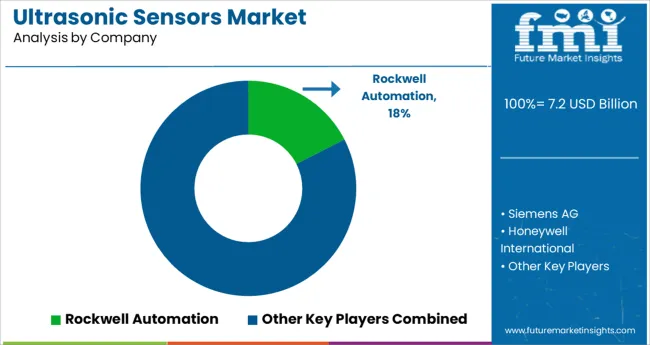
Adoption of push strategy has helped key players to increase flow of their product in the market and reach target customers. With capacity expansion, companies are looking forward to collaboration with global suppliers to ensure their global presence.
Key players in the ultrasonic sensors market are focusing on increasing their production capacity to meet the growing demand from OEM’s and commercial customers.
| Attribute | Details |
|---|---|
| Market value in 2025 | USD 7.2 billion |
| Market CAGR 2020 to 2024 | 12.0% |
| Share of top 5 players | Around 45% |
| Forecast Period | 2025 to 2035 |
| Historical Data Available for | 2020 to 2024 |
| Market Analysis | million for Value |
| Key regions covered | North America; Latin America; Europe; East Asia; South Asia & Pacific; and Middle East and Africa |
| Key countries covered | USA, Canada, Brazil, Mexico, Germany, UK, France, Spain, Russia, China, India, Malaysia, Singapore, Australia, Japan, GCC countries, and South Africa |
| Key market segments covered | Type, Application, Industry, Region |
| Key companies profiled | Rockwell Automation; Siemens AG; Honeywell International; Balluff GmbH; Pepperl +Fuchs AG; Baumer Ltd; Murata Manufacturing Co, Ltd; Crest Ultrasonic; Omron Corporation; Blatek Inc; Keyence Corporation |
| Report coverage | Market forecast, company share analysis, competition intelligence, DROT analysis, market dynamics and challenges, and strategic growth initiatives |
| Customization & pricing | Available upon request |
The global ultrasonic sensors market is estimated to be valued at USD 7.2 billion in 2025.
It is projected to reach USD 22.4 billion by 2035.
The market is expected to grow at a 12.0% CAGR between 2025 and 2035.
The key product types are proximity sensors, retro-reflective sensors, through beam sensors and others.
object detection segment is expected to dominate with a 28.6% industry share in 2025.
Explore Similar Insights

Thank you!
You will receive an email from our Business Development Manager. Please be sure to check your SPAM/JUNK folder too.